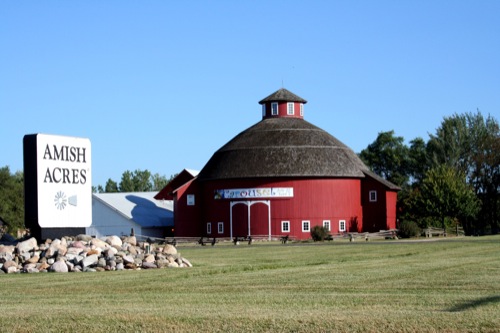
Courtesy Elkhart County CVB
Northern Indiana
Large Amish communities have made their mark on the town and country around Nappanee, Indiana. Although they are often identified by their strict religious practices, the Amish originally came from Germany and brought a large amount of German language and customs to their Northern Indiana surroundings.
One of the best places for groups to experience the area’s Amish heritage is Amish Acres.
“This is an 80-acre Old Order Amish farm that was homesteaded in 1873 by the first Amish family to immigrate to Indiana,” said owner Dick Pletcher. “We have preserved and restored the original farmstead. When we purchased the farm to preserve it in 1968, three generations of the same family had lived on the farm.”
When groups tour Amish Acres, they see many of the clothes, tools and farm implements still used by other Amish living in Northern Indiana. The farm features a German-designed barn and outbuildings such as a food-drying house, where the family dried fruits and vegetables; a brick oven; and a smoke house.
Visitors can connect directly with the Amish and German traditions in the area during a meal, which features food and sweets prepared by Amish sisters according to family recipes.
“We have three Amish sisters who work here,” Pletcher said. “One handles the historic area and the guided tours, another runs the bakery, and the third is the head cook.”
The farm restaurant specializes in Thresher’s Dinners, family-style meals that feature fried chicken, apple butter, pickled vegetables and shoofly pie, a special Amish dessert.
New Ulm
Minnesota
New Ulm, Minnesota, owes its striking German culture to the idealism of the people who founded it more than 150 years ago.
“It’s a town that was founded in 1854 by two groups of German immigrants,” said Terry Sveine, manager of the New Ulm Convention and Visitors Bureau. “They both wanted a ‘utopian German community on the American wilderness.’ The fact that it was utopian is why we’ve kept the tradition so long — they wanted to preserve German traditions, food and language.”
The national census in 2000 found that New Ulm has the highest percentage of German ancestry of any city in the country, and groups can experience that heritage in a number of ways. On a tour of the city, they’ll see the Hermann Monument, a 102-foot statue erected in honor of the leader who united the German tribes against the Romans in 9 A.D. The tour also includes a stop at New Ulm’s 42-foot-tall glockenspiel, where mechanical characters come out to entertain townspeople three times each day.
New Ulm also has troupes of entertainers who carry out typical German traditions. The Concord Singers have been performing German songs since 1932, and a group called the Narren can be found at many local festivals.
“The word ‘narren’ means ‘fools’ in German,” Sveine said. They wear wooden masks made in Germany and funky costumes. They each represent a character, and they appear at festivals and events around town.”
Those events include a typical German Oktoberfest in the fall and Bavarian Blast, a summer festival that features bands from Germany and plenty of German food. Groups can also find German cuisine in a number of restaurants and bakeries in New Ulm.
www.newulm.com
New Glarus
Wisconsin
In the 1840s, a group of settlers from the Swiss canton of Glarus came to the United States looking for a new home. They settled in an area in southern Wisconsin, naming it New Glarus and establishing many of their traditional crafts and businesses.
“New Glarus is known as America’s Little Switzerland,” said Noreen Rueckert, director of Green County Tourism. “The settlers brought their Swiss traditions, Swiss language, Swiss food and Swiss festivals. There are still people here that speak to each other in Swiss German.”
Groups that visit the area can enjoy the Swiss heritage in a number of ways. Among the most popular is a visit to the National Historic Cheesemaking Center, which demonstrates classic Swiss methods. At the Alp and Dell Cheese Store, visitors can watch fresh cheese being made, taste traditional cheeses and take a bag of Wisconsin’s famous cheese curds to go. Other options include a tour of a craft brewery and stops at shops that specialize in Swiss fudge and sausage.
A lot of groups opt to experience another Swiss classic: fondue.
“Bus groups enjoy having a fondue demonstration and learning about how it started,” Rueckert said. “The chef talks to them about it and gives them a sample, and we have people come who yodel and play the alpenhorn.”
The Swiss Historic Village, a replica of the original Swiss settlement in New Glarus, demonstrates the life of early settlers with a church, a general store, a cheese factory and a sausage shop. Groups can also arrange to have a meal in the rathskeller, a Swiss-German-style dining room located in Turner Hall, a Swiss-alpine-style chalet.
www.greencounty.org










